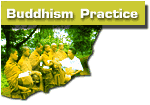 |
BANGKOK
|
||||||||
CENTRAL
|
||||||||||||
NORTHEASTERN
|
||||||||||||||
NORTHERN
|
||||||||||||
SOUTHERN
|
||||
 |
| A GUIDE TO MEDITATION CENTRES IN THAILAND |
| NORTHEASTERN - WAT PAH BAN THAT |
Ajahn
Maha Bua |
MEANING
OF NAME : |
"Forest monastery of Ban That" |
ADDRESS : |
c/o Songserm Service, 89 Phosi Road, Udon Thani 41000 |
DIRECTIONS : |
Located 564 km northeast of Bangkok and 16 km southwest of Udon Thani. Take a songtaew, local bus, or taxi from Udon Thani south 8 km to Ban Gum Kling, then turn southwest 7 km to Ban That and continue one km to the wat. Some songtaews go direct to Ban That from Udon and may even drop you off at the wat entrance. Samlor drivers in Udon usually know where the songtaews depart. Several fast trains provide daily service to Udon, including an overnight express which offers comfortable 2nd class sleepers. Many air-conditioned buses with reclining seats depart Bangkok's Northern (Moh Chit) Bus Terminal for the day or overnight journey. Ubon Ratchathani and other northeastern cities also have good bus connections with Udon. THAI offers a daily flight from Bangkok to the airport just south of Udon. |
MEDITATION
SYSTEM : |
iAnapanasati, mental
repetition of "Buddho" (or "Dhammo" or "Sangho"),
or contemplation of a part of the body is used to gain calm. The
practice of samadhi has 3 levels. First level is characterized by
short periods of calm. Second level has mental images ( nimittas ) during longer periods of calm. The real level of samadhi --
the deep stage which is necessary -- is the third. |
TEACHING
METHOD : |
Ajahn Maha Bua rarely gives talks due to his age but he does meet with visitors in the morning and answers questions. Some of his talks have been translated into English and published in a series of books available at the wat; Forest Dhamma has a fairly complete description of the meditation instructions in English. Guidance in this meditation system of Ajahn Maha Bua is provided primarily by Ajahn Pannavaddho, probably the most senior western monk in Thailand. |
TEACHERS : |
Ajahn
Maha Bua, abbot (Thai; age 77) Ajahn Pannavaddho, vice abbot (English; age 65) |
LANGUAGE : |
Ajahn Maha Bua speaks a little English. Ajahn Pannavaddho speaks English and Thai. |
DESCRIPTION : |
A quiet, forested area of 160 rai (64 acres). Ajahn Maha Bua has chosen to keep the wat simple with a large wooden sala as the only major structure. |
SIZE : |
monks
35-45 novices about 5 nuns occasionally a few laypeople 5-30 |
DAILY
ROUTINE : |
Besides pindabat and the morning meal, the community gets together for cleaning in and around the sala in the morning, then for sweeping and water hauling in the afternoon. Each person practices on his own for most of the day. The only regular group meeting is the fortnightly Patimokkha for monks. |
FOOD : |
Very
good northeastern and Bangkok styles. Monks and novices go on pindabat
in Ban That, then eat one meal. Additional food comes from the kitchen and visiting supporters. Resident laymen can eat in the main sala with the monks and novices. Women eat in the women's area. Drinks and sweets are served in the early afternoon. |
ACCOMMODATIONS : |
Everyone stays in well-separated kutis or in a lan (small roofed platform in the forest). Women live in a separate area of the wat. Some kutis have attached bathrooms or one can bathe at wells. Toilets are Asian- style. Generally no running water or electricity is available. |
WRITE
IN ADVANCE? : |
Not needed. Try to avoid arriving on religiousholidays, especially those on weekends, and during theRains Retreat. |
OTHER
INFORMATION : |
The popularity and renown of Ajahn Maha Bua and his wat, together with limited space, make long-term stays difficult. Laypeople usually can stay up to 2-3 weeks; extensions can be requested. Monks and novices can visit only for short periods too. You can get directions to other wats that use the same meditation system; you'll need to speak Thai at these. Ajahn Maha Bua practiced under the meditation master Ajahn Mun for 9 years; he later wrote a biography of his teacher (see Recommended Reading). |
| Select here : |
|
|
